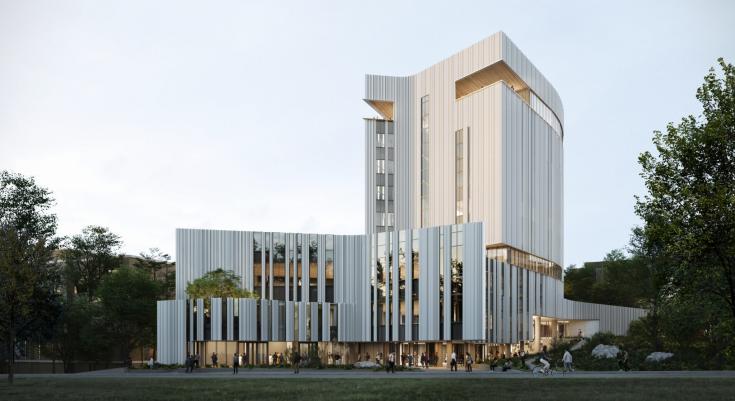
Picture above: 3D Visualization of UBC Sauder School of Business Powerhouse Expansion project, courtesy of ACTON OSTRY + Patkau Architects, rendered by Mute Images
As UBC continues its leadership in campus sustainability, an innovative case study led by Campus and Community Planning (C&CP) will help shape future policies to support the university’s goal of cutting embodied carbon emissions from construction by 50% by 2030.
Embodied carbon refers to the greenhouse gas (GHG) emissions associated with every stage of a building material’s life—from resource extraction and manufacturing to transportation, installation, use, and disposal. Embodied carbon combined with operational emissions caused by building energy use comprise the building’s total carbon footprint. Operational emissions from buildings are declining at UBC thanks to strong energy efficiency and carbon performance requirements and increasing low carbon energy supply. Embodied carbon now represents a growing share of a building’s total carbon footprint and reducing these emissions is critical to tackling climate change.
UBC’s 2030 Climate Action Plan (CAP 2030) sets a target to cut embodied carbon in new building designs and major renovations by half by 2030 compared to a 2010 baseline. The UBC Green Building Action Plan outlines strategies to achieve this, including the use of Whole Building Life Cycle Assessments (wbLCA) to evaluate the carbon impact of building materials and systems.
To put this into practice, C&CP, in collaboration with UBC Properties Trust, recently conducted a theoretical wbLCA of a proposed 11-storey academic building: the UBC Sauder School of Business Powerhouse Expansion. The goal of this study was to test the feasibility of meeting the 50% reduction target using real design information.
The project team used an iterative and collaborative design process to explore alternative structural systems and materials, which are key contributors to embodied carbon. They evaluated various options for their carbon performance, cost, and construction timelines. Industry-average and low-carbon products were assessed by a Life Cycle Assessment consultant, and a construction manager provided cost and schedule estimates to help weigh the trade-offs of each approach.
By grounding this work in a real-world project, UBC is gaining valuable insight into how its climate goals can be achieved. The findings from this study will help guide future green building policy and further the university’s commitment to reducing all emissions associated with campus development.
UBC Sustainability Hub's Urban Innovation Research team has created a case study summarizing this work.